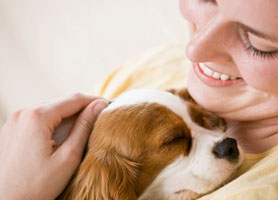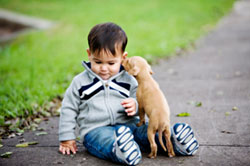How Dogs Show Affection

Love can be defined as "a deep, tender, ineffable feeling of affection and solicitude toward (a person).1 " Most of us have known that same deep and ineffable sentiment toward our pets. And gazing into our dogs’ eyes, we’ve sworn the feeling is mutual. Are canines truly capable of love? Here’s what the experts say.
I am not a morning person. My wonderful dog respects this and does not wake me up in the morning. Ever. Yet somehow he knows when I have opened my eyes. Then he promptly hops off the guest bed and walks into my room to do his morning stretches. When I finally make my way downstairs, he is already there, enthusiastically running around in circles until I take him out for a walk. Always puts a smile on my face—it’s a great way to start the day. - Diana P., Washington, D.C.
A Family Affair
The way dogs relate to us stems from their pack animal roots. In the wild, tight social bonds among pack members are essential to survival. Wolves mate for life and have a very structured family hierarchy. Subordinate wolves approach more dominant ones with respectful gestures such as face-licking, tail-wagging, and a lowered body posture. Rapport among equals is more rowdy, and the excited barking, jumping, and roughhousing are akin to friendship. Pack members protect each other and are very loyal. The entire pack contributes toward feeding and rearing the young. Mated pairs and their offspring might sleep together, snuggled with a paw or head over another’s back. If one wolf is injured in a hunt, the others bring food to him, lick his wounds, and nurse him back to health. Modern domestic dogs are reprogrammed to direct these behaviors toward humans, who are, in essence, their surrogate pack.
Is It Love?
When I was first pregnant, I had some complications and was put on bed rest. My dog would not leave my side. My husband could get him about ten feet outside the front door to take care of his business. Then he would immediately turn around and tug on the leash to get back inside to be with me.
- Shannon A., Newton, MA
We love our dogs, and they seem to love us, but is a dog really capable of such emotions? Is it love as we know it? Or are we just projecting our human feelings onto our dogs?
Some scientists and behaviorists believe that dogs do not feel actual emotions but rather act on instinct alone. Thus the dog that wags her tail and barks excitedly upon your return is performing a stereotypical greeting for a superior pack member. The dog that stands vigil by the sickbed is only heeding a hard-wired instinct toward pack survival. The dog that stares longingly into your eyes is actually just saying "feed me."
A behavioral model of canine affection suggests that dogs learn to "love" us because we unwittingly teach them to do so. We actually train them to wag, lick, bark, and make silly faces for us by rewarding them with snuggles and a treat when they do those things. Our human habit of investing other animals with our emotions then leads us to interpret their resulting behavior as love. Veterinarian Fred Metzger sums up this line of reasoning:
"Dogs probably don't feel love in the typical way humans do. Dogs make investments in human beings because it works for them. . . . The more 'cute factor' they give us, the more we feel like they love us. This makes it more likely that we will give them more attention, food treats, outdoor access—all based on how much of a show they put on for us.2"
We used to call our dog "Baywatch Bodey." Whenever I would go swimming in the ocean, Bodey would pace the beach, whining and yelping until he could break free from his leash. Nothing would stop him until he reached me in the water and I grabbed onto his collar so he could tow me back to safety. Once back on the shore he would strut around so proud that he saved me.
- Caycee H., Seattle, WA
Steven Budiansky, author of The Truth About Dogs takes it one step further. He suggests that dogs, by virtue of their intensely hierarchical social system, are instinctive brown-nosers that know just what it takes to get ahead. Thus, according to Budiansky, dogs have unleashed their uncanny abilities on humans in a survival-of-the-fittest sort of way, thereby winning our hearts, our homes, and a life of luxury that is unheard of in the rest of the animal kingdom.3

Does Love Conquer All?
But what of the dog who sits loyally by the sickbed? Or the dog that repeatedly performs an altruistic rescue-at-sea? Must there always something in it for them? All cynicism aside, it’s tempting to believe that a dog’s affection is real, at least on some level.
Says Dr. Ann Marcario, a veterinarian and dog lover in New York:
"[My dog] seems to know when I am feeling down and gives me more attention at those times. She lets me know when she doesn't like something and when she's having a great time or if she doesn't feel good. She is obedient when I give her directions. She recognizes her "friends" (both people and animal) and greets them enthusiastically."
If it’s not exactly love in the complex human sense, certainly the connection and deep attachment are real. And in most cases, a dog’s loyalty is unconditional. She doesn’t care if your hair’s not washed or if you’re having a bad day. You can ignore, scold, or even forget to feed your dog and he won’t hold a grudge. He’s just happy that you’re you. This type of pure, non-judgmental bond is precious in our jaded and cynical world. Is it love? Or something even better? In the end, the question of whether a dog’s love is real may be nothing more than semantics.
Resources:
- Love. 2010. Dictionary.com. IAC/InterActiveCorp. Retrieved January 26, 2010, from http://dictionary.reference.com/browse/love.
- Cited in Etter, Sarah. 2005. "Does My Dog Really Love Me?" ResearchPennState. Retrieved January 16, 2010, from http://www.rps.psu.edu/probing/dog.html.
- Budiansky, Stephen. The Truth About Dogs: An Inquiry into Ancestry, Social Conventions, Mental Habits, and Moral Fiber of Canis familiaris. New York: Penguin, 2001.
You May Also Like These Articles:
Why Do Dogs Tilt Their Heads When You Talk?
Dogs Make the Best Matchmakers
The Yellow Dog Project: What Does the Yellow Ribbon Mean?
Disclaimer: This website is not intended to replace professional consultation, diagnosis, or treatment by a licensed veterinarian. If you require any veterinary related advice, contact your veterinarian promptly. Information at DogHealth.com is exclusively of a general reference nature. Do not disregard veterinary advice or delay treatment as a result of accessing information at this site. Just Answer is an external service not affiliated with DogHealth.com.
Notice: Ask-a-Vet is an affiliated service for those who wish to speak with a veterinary professional about their pet's specific condition. Initially, a bot will ask questions to determine the general nature of your concern. Then, you will be transferred to a human. There is a charge for the service if you choose to connect to a veterinarian. Ask-a-Vet is not manned by the staff or owners of DogHealth.com, and the advice given should not delay or replace a visit to your veterinarian.


